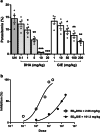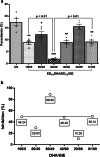Synergistic antimalarial treatment of Plasmodium berghei infection in mice with dihydroartemisinin and Gymnema inodorum leaf extract
- PMID: 36690988
- PMCID: PMC9869572
- DOI: 10.1186/s12906-023-03850-y
Synergistic antimalarial treatment of Plasmodium berghei infection in mice with dihydroartemisinin and Gymnema inodorum leaf extract
Abstract
Background: Chemotherapy is crucial in the fight against malaria. The rise of resistance to most antimalarial medicines has been a serious hurdle to effective treatment. Artemisinin-based combination therapies (ACTs) are currently the most effective antimalarial medication. Malaria parasites are growing more resistant to ACTs, particularly in Southeast Asia. As a result, effective alternative antimalarials are in high demand. The leaf extract of Gymnema inodorum (GIE) has previously shown promise as an effective antimalarial. Therefore, this study evaluated the antimalarial potential of combination dihydroartemisinin (DHA) and GIE therapy against Plasmodium berghei in a mouse model.
Methods: The medications were evaluated using the standard 4-day test for determining the 50% effective dosage (ED50) of DHA and GIE on P. berghei ANKA (PbANKA). DHA and GIE were combined using a fixed-ratio approach, with DHA/GIE ED50s of 100/0, 80/20, 60/40, 40/60, 20/80, and 0/100, respectively.
Results: The ED50 against PbANKA was determined to be 2 mg/kg of DHA and 100 mg/kg of GIE. The 60/40 (DHA/GIE) ratio demonstrated significantly higher antimalarial activity than the other ratios (p < 0.001) against PbANKA, with 88.95% inhibition, suggesting synergistic efficacy (combination index (CI) = 0.68695). Furthermore, this ratio protected PbANKA-infected mice against loss of body weight and packed cell volume decline, leading to a longer survival time over 30 days.
Conclusion: Our results suggest that GIE could be an effective adjuvant to DHA that can enhance the antimalarial effects in the treatment of PbANKA-infected mice.
Keywords: Antimalarials; Dihydroartemisinins; Gymnema inodorum; Plasmodium berghei.
© 2023. The Author(s).
Conflict of interest statement
The authors declare that they have no competing interests.
Figures




Similar articles
-
Gymnema inodorum Leaf Extract Improves Cardiac Function in Experimental Mice Infected with Plasmodium Berghei.J Evid Based Integr Med. 2023 Jan-Dec;28:2515690X221150526. doi: 10.1177/2515690X221150526. J Evid Based Integr Med. 2023. PMID: 36617811 Free PMC article.
-
Evaluation of Antimalarial Potential of Aqueous Crude Gymnema Inodorum Leaf Extract against Plasmodium berghei Infection in Mice.Evid Based Complement Alternat Med. 2021 Apr 27;2021:9932891. doi: 10.1155/2021/9932891. eCollection 2021. Evid Based Complement Alternat Med. 2021. PMID: 33995550 Free PMC article.
-
Effects of Gymnema inodorum Leaf Extract on the Alteration of Blood Coagulation Parameters and Platelet Count in Plasmodium berghei-Infected Mice.J Parasitol Res. 2022 Mar 11;2022:4225682. doi: 10.1155/2022/4225682. eCollection 2022. J Parasitol Res. 2022. PMID: 35310010 Free PMC article.
-
Protective Effects of Gymnema inodorum Leaf Extract on Plasmodium berghei-Induced Hypoglycemia, Dyslipidemia, Liver Damage, and Acute Kidney Injury in Experimental Mice.J Parasitol Res. 2021 Sep 12;2021:1896997. doi: 10.1155/2021/1896997. eCollection 2021. J Parasitol Res. 2021. PMID: 34552764 Free PMC article.
-
The Potential Role of Gymnema inodorum Leaf Extract Treatment in Hematological Parameters in Mice Infected with Plasmodium berghei.J Trop Med. 2021 Jun 28;2021:9989862. doi: 10.1155/2021/9989862. eCollection 2021. J Trop Med. 2021. PMID: 34257672 Free PMC article.
Cited by
-
Relationship of phytochemicals and antioxidant activities in Gymnema inodorum leaf extracts.Heliyon. 2023 Dec 2;10(1):e23175. doi: 10.1016/j.heliyon.2023.e23175. eCollection 2024 Jan 15. Heliyon. 2023. PMID: 38163201 Free PMC article.
-
Antimalarial Drug Repurposing of Epirubicin and Pelitinib in Combination with Artemether and Lumefantrine.Pharmaceuticals (Basel). 2025 Jun 25;18(7):956. doi: 10.3390/ph18070956. Pharmaceuticals (Basel). 2025. PMID: 40732245 Free PMC article.
-
Evaluating the Antiplasmodial Activity of Picrasma javanica Stem Bark Extract and Its Synergy With Artesunate in Rodent Malaria Models.Scientifica (Cairo). 2025 Jun 4;2025:7344444. doi: 10.1155/sci5/7344444. eCollection 2025. Scientifica (Cairo). 2025. PMID: 40501454 Free PMC article.
References
-
- WHO . World Health Organization, World malaria report. 2019.
MeSH terms
Substances
LinkOut - more resources
Full Text Sources
Medical
Research Materials

